History
Since the establishment in 1973,
Oshima Shipyard has been trying to unite together and mutually prosper with local community.
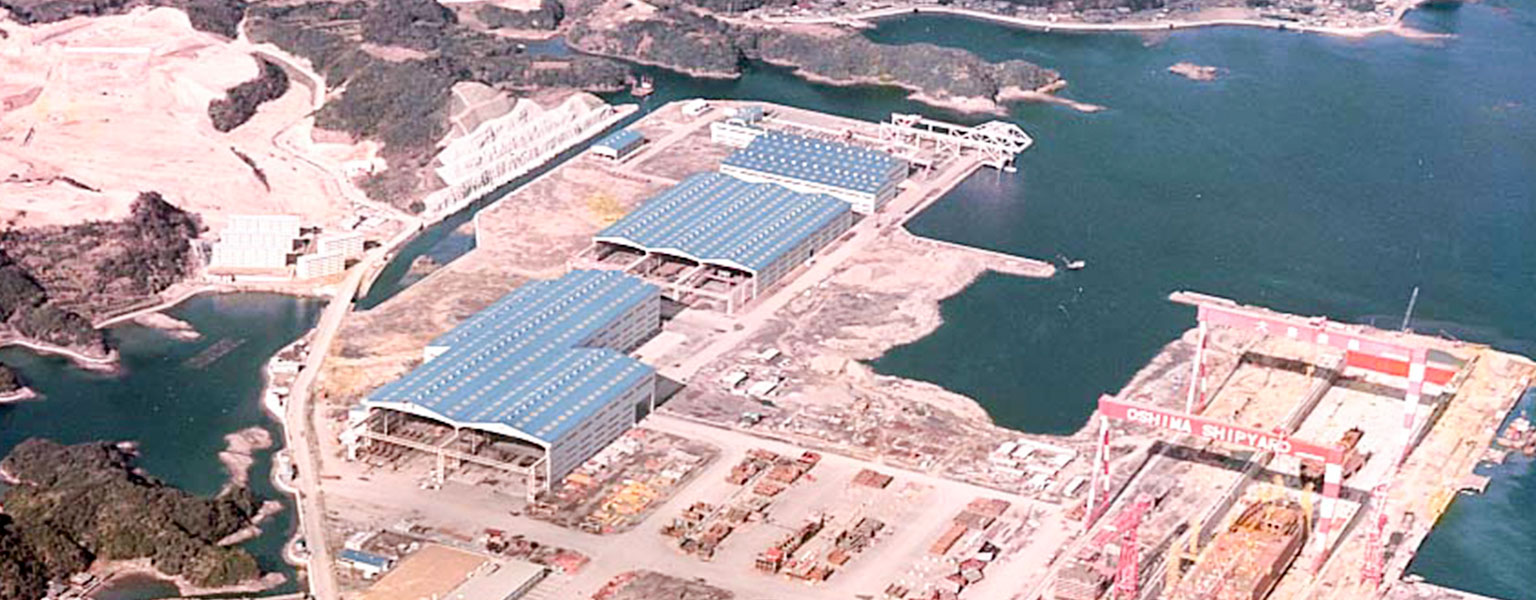

History of Oshima Shipyard
In Oshima Town, Saikai City, Oshima Island where Oshima Shipyard is located is at 1 km off the coast of mainland Kyusyu. It was developed as an island of coal mine since early 20th century, but the coal mine was closed down in 1970, and the local government started to attract other industry. On the other hand, Osaka Shipyard (current Daizo Corporation), parent company of Oshima Shipyard, was looking for suitable location to build the most-advanced shipyard with efficient production facilities in order to establish the foundation of the company and for its future development to cater for market demand for larger ships. Intentions of both parties matched, and Oshima Shipyard was born.
Establishment
2nd July, 1973
(Steel cutting started on 1st June 1974)
Reason to expand to Oshima City:
- There was an eager invitation and full support from Nagasaki Prefecture and Oshima Town.
- Nagasaki Prefecture is a shipbuilding industry oriented prefecture, residents are familiar with the shipbuilding industry, and supply chain for the shipbuilding was developed.
- Reclaimed land from the time of coal mine (half of our current site) was available, and electrical facilities could be used without alteration.
- Geographical conditions is suitable for shipbuilding. (Climate is moderate and is a good natural port with depth of nearly 20 meters.
1935〜
1935
Oshima Coal Mine of Matsushima Tanko Co., Ltd. opened.
Opening of coal mine triggered development of Oshima Island of agriculture and fishing.
1949
Establishment of Oshima Town.
The island bacame “Oshima Town” with the population of 14,000.
1959
Maximum population recorded.
Population of the island reached maximum of 19,453 as coal mining industry prospered, but coal industry started to decline due to the rise of petroleum in the early 1960’s.
1970
Announcement of building new shipyard by Osaka Shipyard.
President of Osaka Shipyard (current Daizo Corporation) who was operating business in Osaka announced to build a new shipyard to prepare for future expansion.
May. 1970
Closure of coal mine.
Coal mine in Oshima was closed down due to worldwide energy shift from coal to petroleum, and Oshima town became depopulated. The population of Oshima town dropped sharply.
Year 1970 (just after closure of coal mine) ・・・11,197
Year 1972 :・・・5,942
Oct. 1970
Start attracting enterprises.
Nagasaki Prefecture in cooperation with Oshima Town started activities to attract new industry that would operate business in Oshima.
1971
Start inviting Osaka Shipyard.
Nagasaki Prefecture and Oshima Town started inviting Osaka Shipyard. In response to their invitation, Osaka Shipyard dispatched feasibility study team to Oshima in the same year.
1972
Approval for building a new shipyard.
Osaka Shipyard applied for building a new shipyard to government authority in May and was granted approval in July.
Dec. 1972
Groundbreaking ceremony at Oshima Island.
7th Feb. 1973
Establishment of Oshima Shipbuilding Co., Ltd.
Oshima Shipbuilding Co., Ltd. was jointly established by Osaka Shipbuilding Co. Ltd., Sumitomo Heavy Industries, Ltd. and Sumitomo Corporation. It was headquartered at Oshima Town. At the time of foundation, basic direction was aiming to build oil tankers.
The founder, Kageki Minami, gave following directions to secure the possibility for future expansion.
- Secure large ground. Keep excess land at the center of the ground.
- Make dock size large and secure enough space at dockside and dockhead.
- Factory buildings should be independently distributed and as tall as possible.
Consequently,
- The secured ground was 6 times as wide as Osaka Shipyard. Room for future expansion was secured at the center of the ground and made flow of building process simple.
- Constructed dock was as large as 535m long and 80m wide. Vast assembly yard was secured not only at dockside but also at dockhead.
- Factory buildings were independently distributed to accommodate build of different types of ships other than tanker. They were built tall, considering changes in the method of shipbuilding in the future.
Oct. 1973
Occurrence of oil crisis
1st Jun. 1974
Oshima Shipyard started with steel cutting
A town of coal mine revived as a town of shipbuilding.
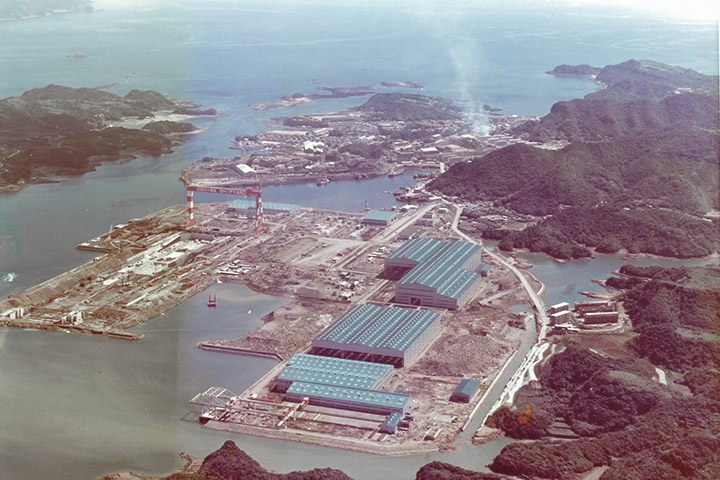
Feb. 1970
Launching of first ship
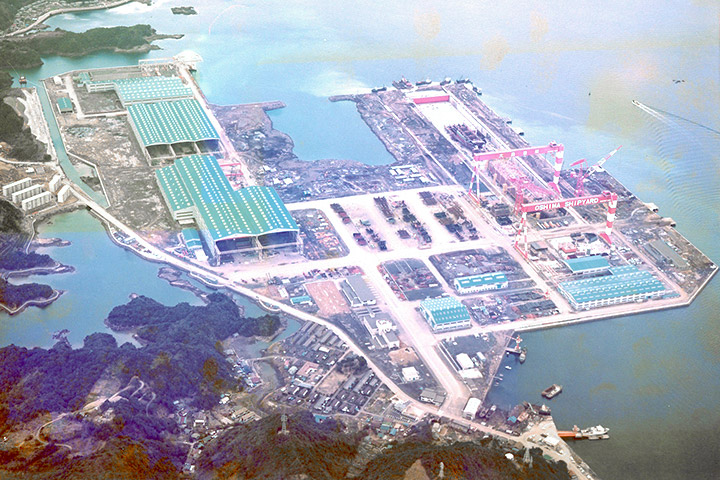
1975
Recession on shipbuilding industry became notable.
Due to worldwide recession on shipbuilding industry, contracted tanker was canceled just after establishment of the business. Oshima Shipyard was forced to trim down the operation before it gets full-scale.
Jul. 1978
Disadvantageous change of labor condition.
Conducted wage cut, extension of annual prescribed working hours, suspension of company-subsidized lunch, etc.
1980
First facility disposal under Government policy.
As a countermeasure to recession on shipbuilding industry, by the government authority announcement, reduction of supply capacity by joint disposal of building facilities across entire shipbuilding industry was conducted.
Jun. 1981
Shozo Doi assumed office of president of the company.
Jul. 1981
Reversion of labor condition.
Dec. 1982
Opening of Seiun-Gakush.
Tutoring school, “Seiun-Gakusha”, was opened for children of shipyard employees and local residents for their academic development.
1983
Foundation of Oshima Island Hotel.
Oshima Island Hotel was founded to promote regional development. It served as a guest house for shipyard customers as well as a base for cultural and resort activities in the remote island.
Apr. 1985
Establishment of Oshima Shuzou Co., Ltd.
Oshima Shuzou Co., Ltd was established with joint capital contribution by local government and local brewing company in order to develop reginal industry.
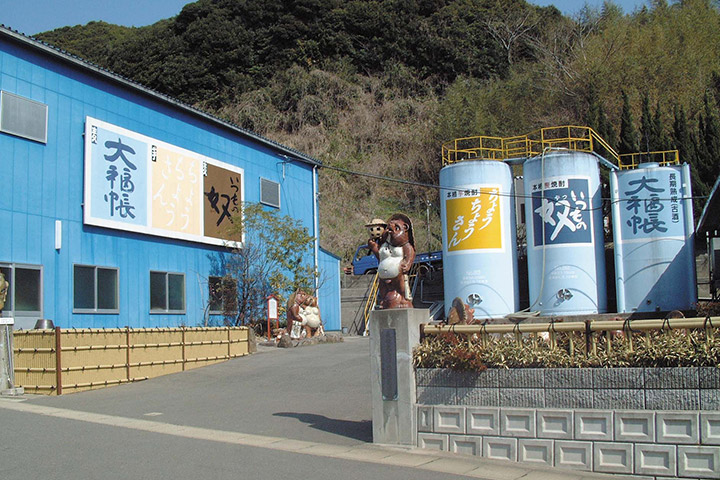
Sep. 1985
Temporary dispatch of employees started.
In order to avoid lay-offs at the time of recession, Oshima Shipyard dispatched employees as temporary worker to other companies including car industry, such as Denso Corporation, Hino Motors, Suzuki Motor Corporation and Daihatsu Motor Co., Ltd, etc. The duration was as long as 3 years and 7 months and the total number was 6,459, 60% of all employees experienced this
1987
Disadvantageous change of labor condition.
Due to unpredictable shipbuilding market, reduction of training, wage cut, reduction of annual bonus payment to one month equivalent, and reduction of overtime premium rate was carried out.
Feb. 1987
Naming ceremony for 100th ship.
Dec. 1987
Oshima Shipbuilding Co., Ltd was newly established through capital reduction and write-off of loss in the past in order to improve business foundation.
1988
Started tomato cultivation.
In order to make better use of unused land in the island and to create employment, Oshima Shipyard started growing tomatoes, which are still specialty of Oshima Island.

1988
Second facility disposal by the Government policy.
Facility disposal was again required by the government so as to reduce supply capacity. Osaka Shipyard, a parent company, closed its shipbuilding business and decided to preserve Oshima Shipyard.
1990〜
Feb. 1989
Restoration of labor condition.
Excluding extension of prescribed working hours.
Jun. 1989
Sho Minami became president.
Mar. 1991
Restoration of labor condition.
All the undercut of labor condition since 1986 was restored.
1991
Setting principle: “Concentration on Bulk Carriers”.
Oshima Shipyard aimed to increase the number of ships to be built by focusing to bulk carriers, as its result, build high quality ships with low cost under concentration effect.
Jul. 1993
The first Oshima Triathron.
As a part of contribution to the local community, Oshima Shipyard has been supporting the event since the first time until now as special supporter. It has now become an event attracting a few hundred participants from in and outside of the region.
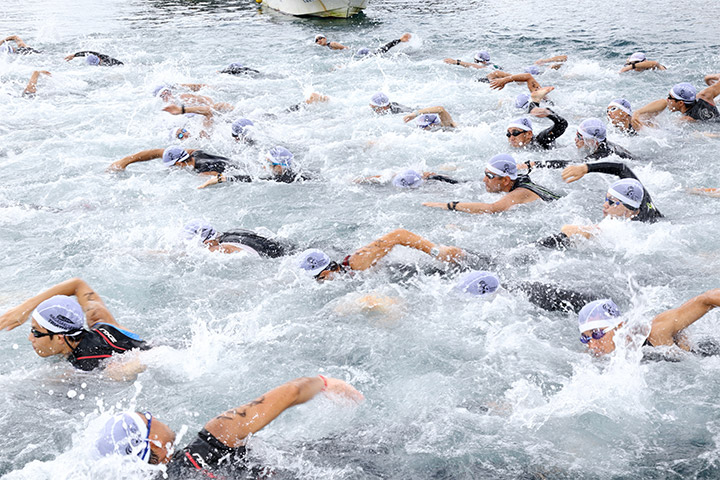
Jan. 1994
Declaration of the state of emergency and fly of Z flag.
Under forecasted appreciation of the yen against US dollar of more than 80 yen, Oshima Shipyard declared state of emergency and flew Z flag.
May 1995
Visit of Prime Minister Mahathir bin Mohamad of Malaysia to Oshima Shipyard.
Prime Minister Mahathir took an interest in Oshima Shipyard, who won a contract in a competition against Hyundai Heavy Industry of Korea and visited Oshima to attend a naming ceremony.
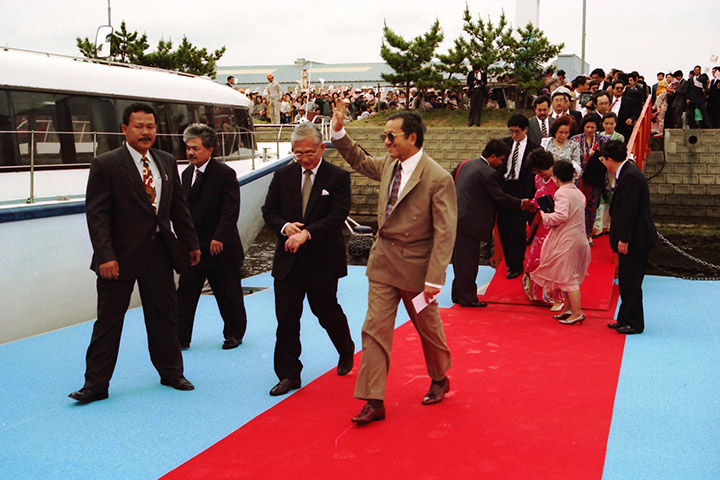
Jan. 1997
Lowered Z flag and flew new symbol flag
In the new year, Oshima Shipyard lowered Z flag which had been flown for 3 years to declare state of emergency, and flew “Ace Flag”.
Meaning of Ace Flag
- Anchor
Anchored at the local community and wish the development of core business. - Tomato
Red tomato covering Oshima Island like a prairie fire, aiming for development of second and third business domains and coexistence with local community. - Pensée
Represents sincere speech and action of each, not attached to old customs and be cheerful, be strong, be positive and be gentle to challenge everything. - Color
Red :the Sun and stars, future and hope.
Green : Mountain forest and plain field, safety and fertility.
Blue : Sky and sea, dreams and cosmos.
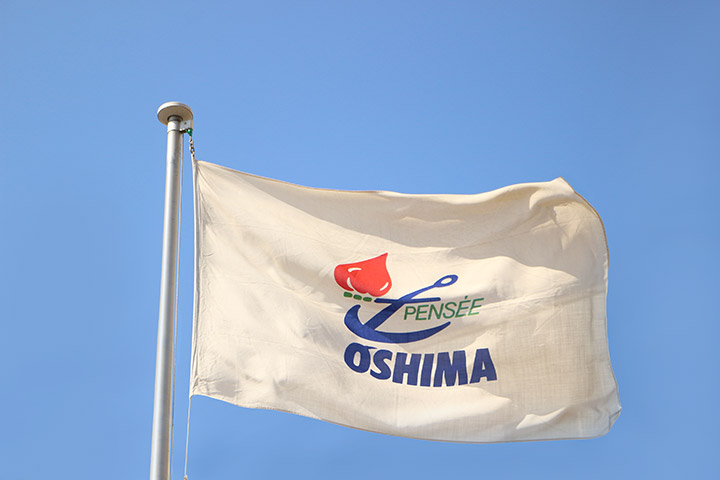
Apr. 1999
Start recruiting female employees.
Anticipating women’s increased participation in the workplace, Oshima Shipyard recruited 4 female technicians and installed facilities for women such as rest rooms and shower in the factory.
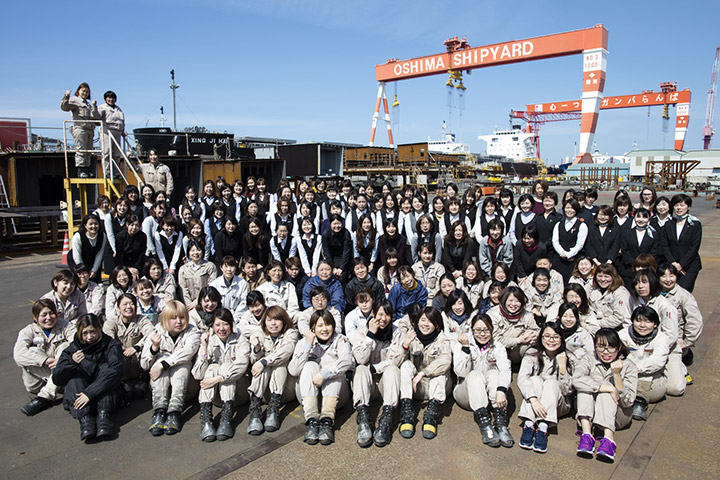
Nov. 1999
Inauguration of Oshima Bridge (length 1095m), which made Oshima “To a part of peninsula from remote island”.
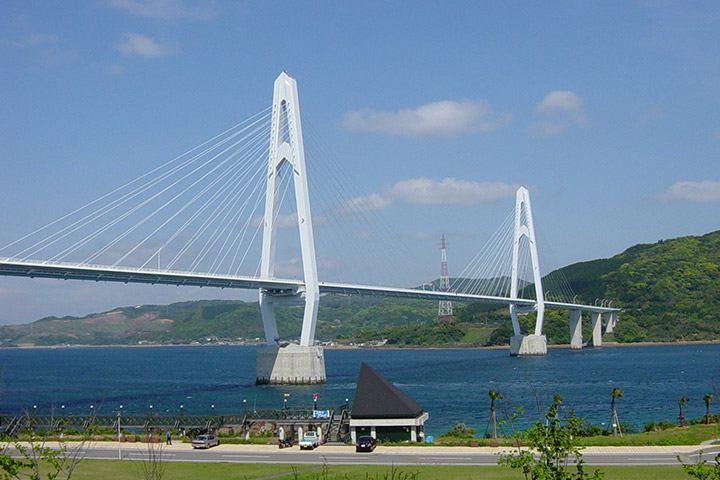
Mar. 2001
King Harald V of Norway paid official visit to Oshima Shipyard.
King Harald V enjoyed site tour at assembly factory guided by our president Sho Minami and attended keel laying ceremony of a ship ordered by Norwegian ship owner. He shared his impression, “This is a clean and perfect shipyard.”
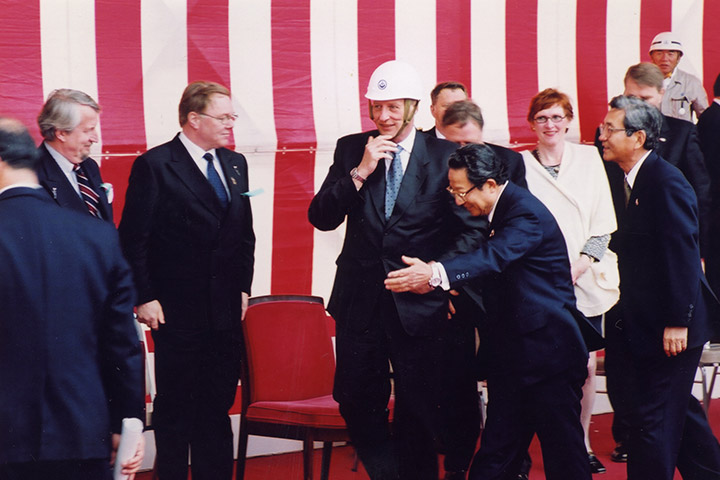
Jul. 2003
Agreement with the Graduate School of Engineering, Kyusyu University regarding comprehensive collaboration.
Jun. 2005
Tadashi Nakagawa became president.
2006
Started training at Toyota Motor Corporation Operations Management Consulting Division.
Oshima shipyard started a program that dispatches its staff to Toyota Motor Corporation. They learn Toyota Production System for two years and inport the best practice of automobile industry into shipbuilding industry.
Jun. 2006
Establishment of Daizo Tec Co., Ltd.
As measures against decreasing number of engineers in Japan, Oshima Shipyard established Daizo Tec Co., Ltd. in Hanoi, Vietnam to secure outstanding design engineers. Now it has more than 100 employees actively working as a member of Oshima Shipyard group.
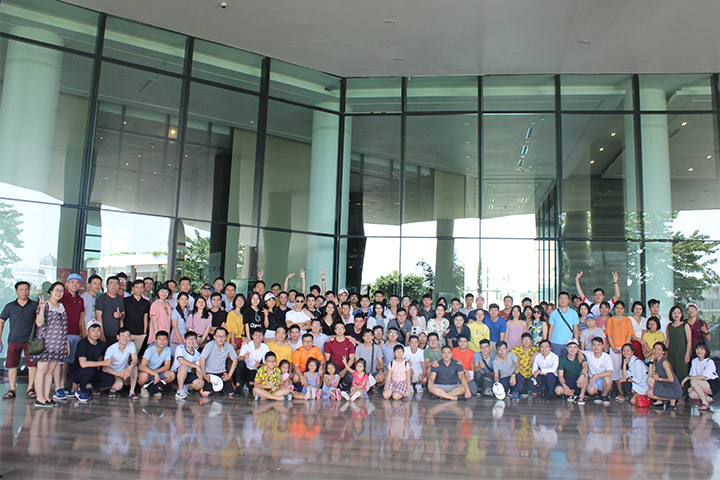
Oct. 2007
Completed land reclamation of reserved area and NO.3 wharf.
Oshima Shiypard reclaimed the area which was reserved for future expansion since the launch of the shipyard and established the infrastructure for large number production.
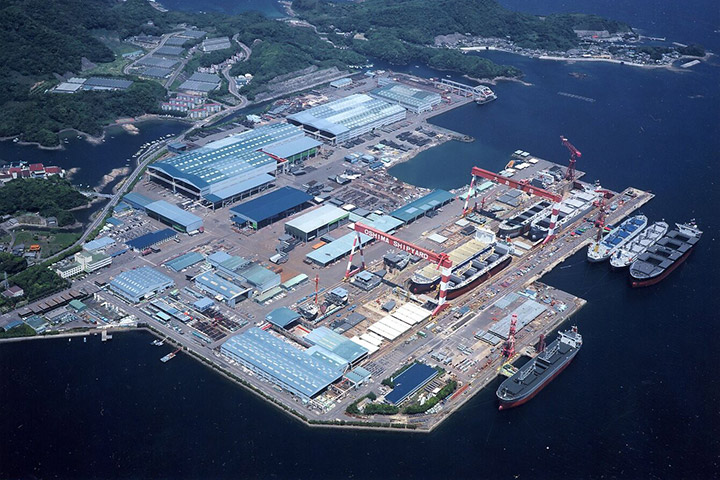
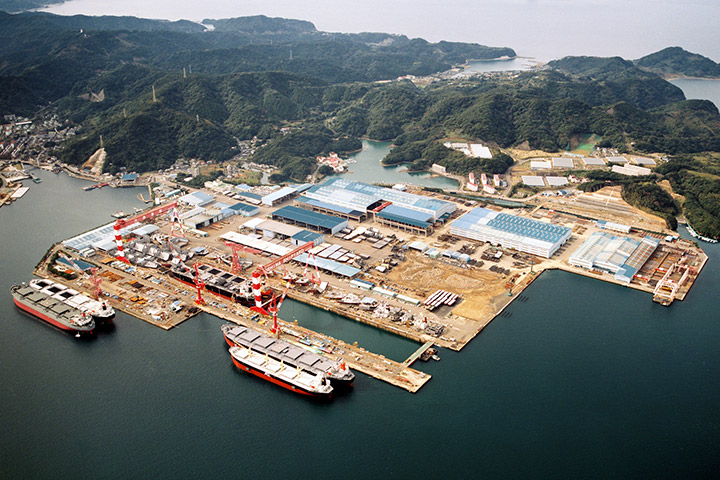
Jun. 2008
Launch of No.1 1200 ton goliath crane.
In addition to existing two 300 ton goliath crane, 1200 ton goliath crane was installed. As a result, the dock has three goliath cranes in total.
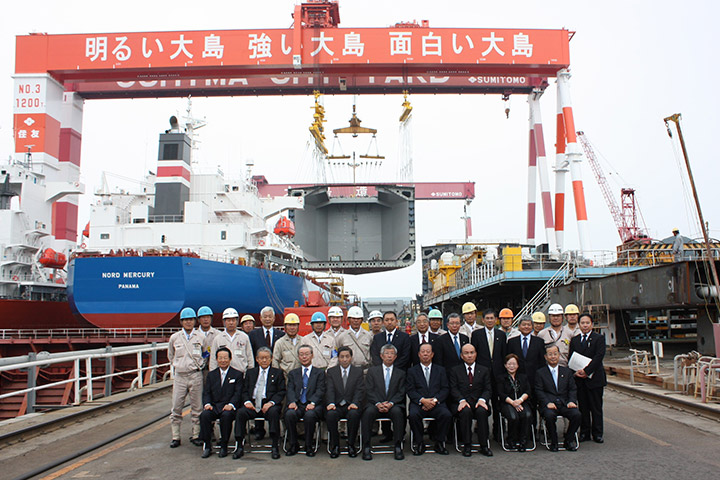
Sep. 2008
Z flag was flown again.
In response to critical situation of sharp rise in material cost, Oshima Shipyard flew Z flag again and started its effort to reduce labor, energy and resources.
2009
Launch of “Wind Challenger Project”, development of wind propulsion vessel, with the University of Tokyo and shipping companies.
Oct. 2009
Awarded by Director of Nagasaki Labor Bureau on promoting women’s participation in the company.
Jun. 2009
Hiroshi Minami became president.
Jul. 2009
Establishment of IKNOW Machinery Co., Ltd.
Following the bankruptcy of a ship machinery company in Sasebo, Oshima Shipyard took over its business. With capital contribution from 10 companies in shipping and shipbuilding industries, Oshima Shipyard injected its production know-how into it to be a self-sustaining business, aiming to contribute to the local community and shipping industry.
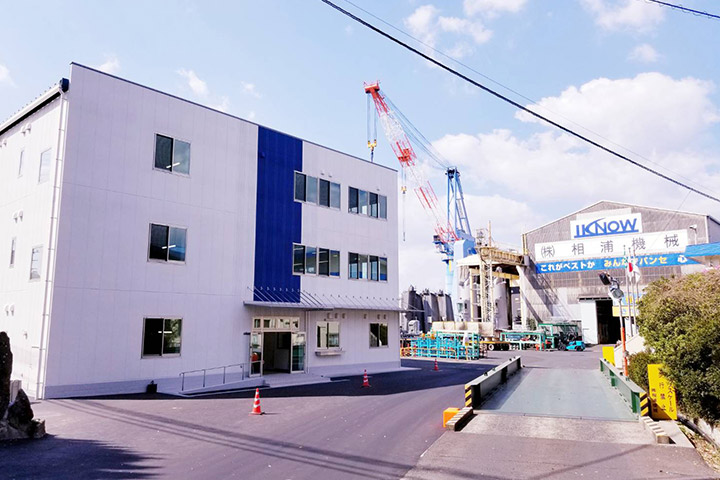
2010
Awarded by the governor of Nagasaki Prefecture on child-rearing support.
Oshima Shipyard was awarded for its proactive effort in promoting work and child-rearing balance, enabling female employees to work with peace of mind.
Jan. 2010
Delivery of 500th ship
Aug. 2010
Opening of Oslo office.
Oshima Shipyard started promoting collaborative study with DNVGL and support activity for marketing and designing.

Aug. 2011
Closing of Oshima Shipyard’s guest house Olive Bay Hotel.
Apr. 2013月
Opening of Oshima Shipyard’s guest house Olive Bay Hotel.
Taking over the site of Oshima Island Hotel, Olive Bay Hotel was constructed as a new guest house of Oshima Shipyard. It was designed by globally known architecture, Kengo Kuma.
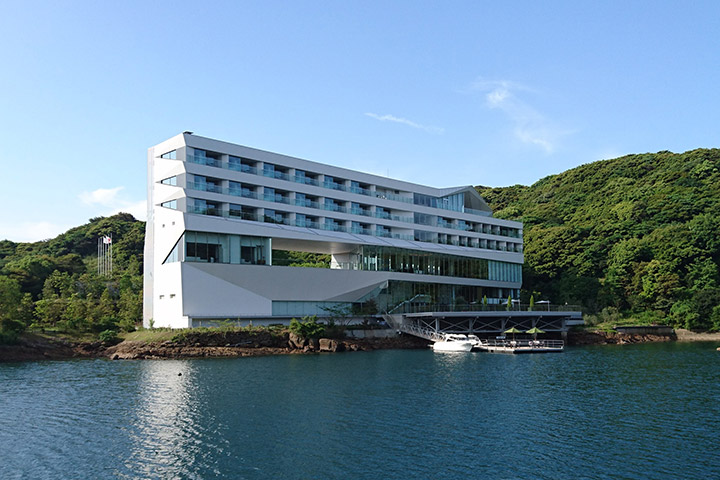
Jun. 2013
Awarded “Ship of the Year”.
700th ship delivered in July 2012 was awarded “Ship of the Year 2012”, an award bestowed to the most outstanding ship every year. This is the first ship equipped with epoch-making technology, air lubrication system.
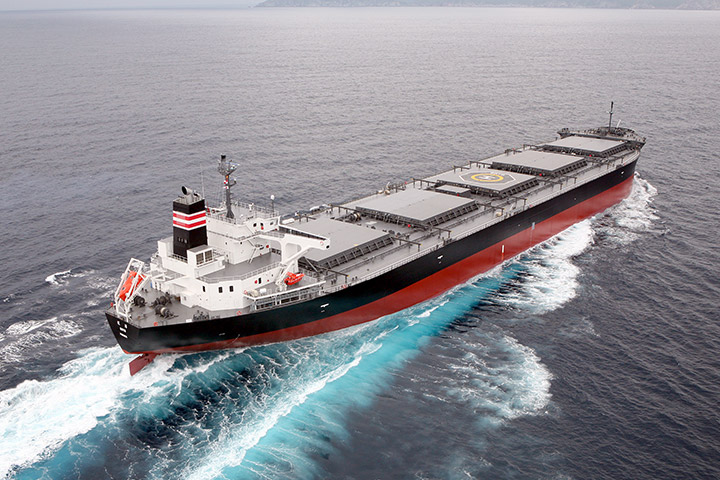
Jan. 2014
Opening of the Advanced Technology Innovation Center.
Oshima Shipyard installed circulating water tank which enables test in flowing water in the shipyard to speed up the development of energy saving hull forms and devices.
Oct. 2014
Opened tutoring school “Chisho-kan Seiun-Gakusha”.
In order to overcome the geographic handicap, Oshima Shipyard reopened tutoring school “Seiun-Gakusha”to support education of children in Oshima island. Making use of internet technology realized the same education level as that of big cities.
Dec. 2014
Launch of No.2 1200 ton goliath crane.
As a result, the dock has two 1200 ton cranes and two 300 ton cranes, total 4 cranes in the dock.
Jan. 2015
Nobuyuki Minami became president.
Oct. 2015
Delivery of 700th ship.
Jun. 2019
Delivery of 800th ship.
Sep. 2018
Eiichi Hiraga became president.
Jun. 2019
Completion of e-Oshima.
Aiming for zero emission of greenhouse gas such as CO2 and air pollutants such as NOx and Sox, Oshima Shipbuilding developed all-electric-battery-driven ferry boat “E/V e-Oshima”. The ship was awarded “Good Design Award 2019”.
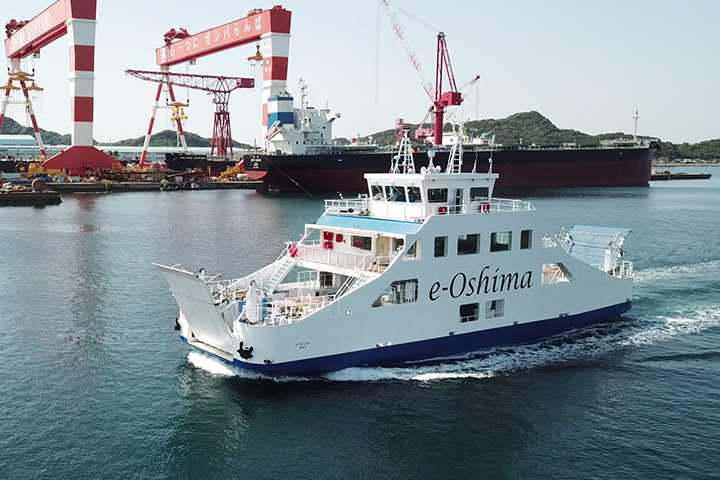
Jun. 2024
Makoto Yamaguchi became president.